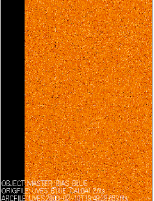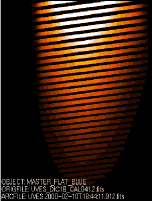UVES: ECH Calibration recipes
BIAS
BIAS frames: uves_cal_mkmaster
DPR CATG = CALIB, DPR TYPE = BIAS
 |
Raw BIAS frame
|
Purpose.
Bias frames are measured to monitor the status of the CCD camera. They come in stacks of 5 raw frames. They are routinely measured every night when UVES is operational. They are all processed into master_BIAS frames and quality-checked.
Recipe.
The pipeline recipe uves_cal_mkmaster determines median stacks of all input frames and produces a master BIAS frame.
QC checks.
The QC1 parameters median values, read noise and overall structure in the master BIAS are monitored.
Products.
| product category (PRO CATG) | product number* |
| MASTER_BIAS | 0000 (+0001) |
* numbers in brackets refer to REDU CCD, others to BLUE or REDL CCD.
 FORMAT CHECK
FORMAT CHECK
FORMAT CHECK frames: uves_cal_predict
DPR CATG = CALIB, DPR TYPE = LAMP,FMTCHK
 |
Raw formatcheck frame (echelle orders from left to right, slightly inclined), and positions found by the UVES pipeline as first guess solution (squares).
|
Purpose.
Formatcheck exposures are obtained with the ThAr wavelength calibration lamp. A short slit is used to measure the positions of the calibration lines and obtain a first-guess dispersion solution. This file is required for automatic pipeline processing only.
The geometric calibration of echelle spectra is a complete definition of the spectral format including the order position and the wavelength associated to each detector pixel. This step was traditionally carried out in echelle spectrographs via visual identification of a few lines. In order to predict the dispersion relation of UVES and to efficiently calibrate all possible optical configurations in an automatic way, many new methods had to be developed. The high non-linearity of the dispersion relation has made necessary to develop a physical model of dispersion. The precision with which the geometric calibration is performed determines the accuracy of all successive steps, in particular the optimal extraction and the photometric calibration.
The positions of a few hundred well separated ThAr lines contained in a reference table are predicted by the physical model and their central positions are projected onto the format-check frame.The lines are found in the narrow Th-Ar frame by a two-dimensional centering procedure. The initial dispersion relation, usually based on about a hundred initial detections is refined with successive iterations on the spectrum until most lines are found.
Recipe.
The pipeline recipe uves_cal_predict does a fit to the physical model to obtain a first guess solution for the dispersion. In principle it is also possible to perform an order tracing here, but this is achieved with a higher precision with order definition flats.
Guess line table.
The guess line table is used downstream in the calibration cascade to achieve the final dispersion solution from ThAr lamp exposures.
Although preliminary, this first guess line table is very important for the following steps since it replaces the interactive
line selection traditionally done for echelle reduction.
QC checks.
The format-check recipe generates a control plot to provide a quality check of the model and of the stability of the instrument configuration. These plots are evaluated by QC Garching. The differences between the predicted and measured position of the calibration lamp lines are plotted as a function of the position on the detector. Typically a thin, well-clustered distribution of the displayed points, with mean value near zero, is a direct indication of good model prediction (a). On the contrary a randomly scattered distribution indicates a mismatch, e.g. due to a grating shift (b).
 |
Match and mismatch of physical model and format check frame. The normal result obtained after successful line matching (a) produces a well concentrated distribution with mean ordinate zero. A misalignment causes a failure of line matching (b). Top row: difference in X direction, bottom row: Y direction
|
Furthermore, as part of the QC1 checks performed by the pipeline, the solution is compared with a reference formatcheck exposure (only for certain standard settings). A set of four such formatcheck frames is obtained for QC purpose every night when UVES is operational.
The shifts of the actual solution with respect to the reference frame are determined both in X (dispersion) and Y (cross-dispersion direction) and logged as function of temperature. Furthermore, the shifts determined between the actual solution and the physical model are stored.
Products.
| product category (PRO CATG) | product number* | comments |
| LINE_TABLE (guess) | 0000 (+0004) | (guess only) |
| ORDER_TABLE (guess) | 0001 (+0005) | (guess only) |
| BACKGROUND_TABLE (guess) | 0002 (+0006) | (guess only) |
* numbers in brackets refer to REDU CCD, others to BLUE or REDL CCD.
 ORDER Definittion
ORDER Definittion
ORDER DEFINITION frames: uves_cal_orderpos
DPR CATG = CALIB, DPR TYPE = LAMP,ORDERDEF
 |
Raw order definition flat (echelle orders from left to right, slightly inclined).
|
Purpose.
Order definition flats are taken with a short slit (0.5 arcs) and a continuum flat lamp. They are processed to find automatically the central positions of each echelle order and of the inter-order background. This file is required for automatic pipeline processing only.
This kind of exposure provides an accurate position of the spectrum along the cross-dispersion direction. In this step the physical model uses the information on the instrument configuration provided in the FITS header of the raw frame to estimate the number of orders present in the image. Hough Transform detection is then applied to find the central position of each order and an estimate of their slope at the center. Finally the cross-order profile is centered along the order and a polynomial fit is performed.
Recipe.
The uves_cal_orderpos recipe processes the order definition flats. The positions are found through a Hough transform algorithm.
Products.
| product category (PRO CATG) | product number* |
| ORDER_TABLE | 0000 (+0003) |
| BACKGROUND_TABLE | 0001 (+0004) |
* numbers in brackets refer to REDU CCD, others to BLUE or REDL CCD.
 flat
flat
FLAT frames: uves_cal_mkmaster
DPR CATG = CALIB, DPR TYPE = FLAT
 |
Flat lamp frame (echelle orders from left to right, slightly inclined).
|
Purpose.
Flat calibration frames are taken with a long slit and the continuum flat lamp. They measure fringing (in the red), fixed-pattern noise and the approximate blaze function.
For 346nm settings, additional flats are measured with the Deuterium lamp providing more response in the extreme blue, but producing emission lines at longer wavelengths. For the RED 600 1x1 setting, additional flats are measured with the absorption cell being switched on. The cell produces a rich absorption line spectrum.
Recipe.
The uves_cal_mkmaster recipe, after bias subtraction, creates a median stack from all raw input frames, in order to reject statistical outliers due to e.g. cosmic ray events.
The stacked frames are finally interorder background subtracted, with a two-dimensional fit to the interorder background positions as given by the order table.
The fitted background is available as additional product
QC checks.
As part of the QC1 checks performed by post-pipeline procedures, noise (photon noise, fixed-pattern noise) and structure parameters (fringing, slit function) in the raw and master FLAT are monitored. The flat lamp efficiency and its stability is also checked.
Products.
| product category (PRO CATG) | product number* |
| MASTER_FLAT | 0000 (+0002) |
| BCG_FLAT | 0001 (+0003) |
* numbers in brackets refer to REDU CCD, others to BLUE or REDL CCD.
 Wavelength Calibration
Wavelength Calibration
Wavelength calibration frames: uves_cal_wavecal
DPR CATG = CALIB, DPR TYPE = LAMP,WAVE
 |
Wavelength calibration frame (echelle orders from left to right, slightly inclined).
|
Purpose.
Wavelength calibration frames are taken with a long slit and the ThAr arc lamp. They are used to find the final dispersion relation.
Three independent wavelength calibrations are performed along the slit to take into account the potential effects of slit curvature.
Three sub-windows are identified along the slit, one for the object and two for the sky, all equal in size.
The initial (first-guess) dispersion relation produced with the format-check frame is refined on each sub-window.
Recipe.
The uves_cal_wavecal recipe uses the first-guess linetable to find the strongest lines in the arc frame.
Then the reference line table is used to match the fainter lines from which the dispersion relation is determined. The dispersion solution is derived for the three different subwindows of the slit (lower sky, object, upper sky) and returned as LINE_TABLE containing 3 extensions (WIN1, WIN2, WIN3). This strategy is chosen to properly deal with potential slit curvature effects.
For optimum extraction, only LINE_TABLE for WIN2 is used. Average extraction makes use of all three LINE_TABLEs.
QC checks.
From the dispersion solutions, the median and mean values of the resolving power R and the FWHM of the identified lines (in px) are recorded. Furthermore the standard deviation of the dispersion solution is stored.
Products.
| product category (PRO CATG) | product number* |
| LINE_TABLE | 0000 (+0004) |
* numbers in brackets refer to REDU CCD, others to BLUE or REDL CCD.
 standard stars
standard stars
FLUX standard star frames (uves_cal_response)
DPR CATG = CALIB, DPR TYPE = STD
 |
Flux standard star exposure (echelle orders from left to right, slightly inclined).
|
Purpose.
Observations of flux standard stars are performed every few nights. Three dedicated dichroic settings are used (346+580, 390+564, and 437+860, 1x1 binning). STD spectra are taken with the 5" or 10" slit. They are used to serve two purposes:
derive the response curve needed to flux-calibrate the extracted science spectrum. The response curve provides a (relative) flux calibration which is better than the correction by the flat lamp (which corrects for the order-by-order blaze function, but still contains the lamp spectral slope). Since STD stars are observed during twilight under varying conditions,
it is recommended to use the master response curves for flux calibration if they are
available for the given setting and the epoch.
the overall efficiency (DQE) of telescope+instrument+detector (corrected for atmosphere). This function is evaluated for monitoring the instrument.
Recipe.
The uves_cal_response recipe reduces a standard star spectrum in exactly the same way as uves_obs_scired does with science spectra (including usage of the same calibration data). Then the target coordinates are used to find in the appropriate flux reference table the standard star flux and the standard star spectrum is divided by the tabulated physical flux. The response curve is corrected for exposure time, gain, detector binning, and extinction, and the final product is re-binned to 50 A resolution.
Slit losses are not taken into account here. In first order they should be purely geometric (as estimated in the ETC). There will also be an chromatic part since the size of the seeing disk is a function of wavelength. Using the response curve, relative flux calibration are nevertheless possible to a reasonable level. For absolute flux calibration, standard stars should be observed together with the science targets, with identical slit widths.
The efficiency is applied by a different, simplified reduction: an average extraction is done, sky subtraction is applied in a simple way, a standard extinction correction is done. The counted electrons are converted into photons and compared to the expected number of photons and the nominal numbers from the ETC.
Products.
| product category (PRO CATG) | product number* |
| INSTR_RESPONSE | 0000 (+0003) |
| EFFICIENCY_TABLE | BLUE:0003, REDL:0006 (+0007) |
* numbers in brackets refer to REDU CCD, others to BLUE or REDL CCD.

|
 mirror sites:
PL (internal link)
HQ
[?]
mirror sites:
PL (internal link)
HQ
[?]
 FORMAT CHECK
FORMAT CHECK
 ORDER Definittion
ORDER Definittion
 flat
flat
 Wavelength Calibration
Wavelength Calibration
 standard stars
standard stars







